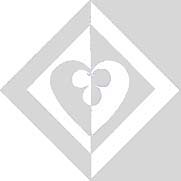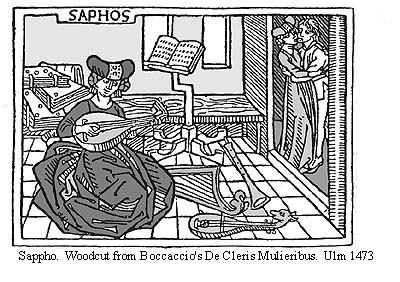
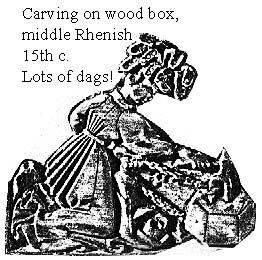
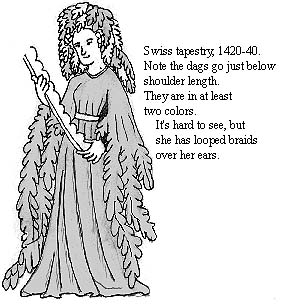
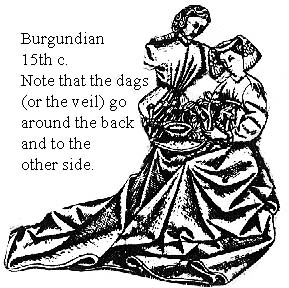
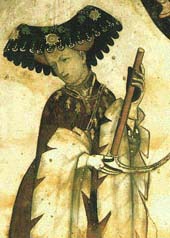
The stuffed hat (some call them bourrelets, or the large Italian balzo, which may have been partially supported by reeds) is an easy and entertaining accessory to the clothing of the high middle ages. It requires very little labor, and produces a marvelous effect for such small effort. Once your hat is made, a very good look can be achieved by braiding your hair in two plaits and looping it over your ears, like the woodcut of Sappho or the Swiss tapestry lady.
I like to have my hats match my
garb, but I have seen only one medieval hat that matched the dress it was
worn with, so go wild with lengths of fabric that you can't bear to throw
away. You can trim these hats with dags, bells, "nailheads", beads, etc.,
and you can "parti" them, too.
The stuffed torus (donut) hat seems to have evolved from the basic
men's hood, although I have heard theories that it was a novel idea brought
back by crusaders who had seen turbans in their travel. Although there
are some circular women's hats that look very turban-like,
I give greater credence to the hood derivation.
In the medieval pictures, these hats are worn with either the basic voluminous houppelande, the Burgundian houppelande, or sometimes with a full-skirted, scoop necked cotehardie.
Let's run through hoods very briefly (if you're very interested in hoods, see my other class notes on hoods.) If you take a basic hood (figure 1), take it off your head, roll up the face opening, and put it back on your head with the face opening around the top of your head (figure 2), you get a hat. There are several extant pictures of men doing this with their hoods from as early as 1316 (fig. 3). Eventually the "liripipe" (the tail at the back of the head) became longer and decorated, as did the skirt fabric which lies over the shoulders. (fig 4. from a tapestry in the mid-15th century.)
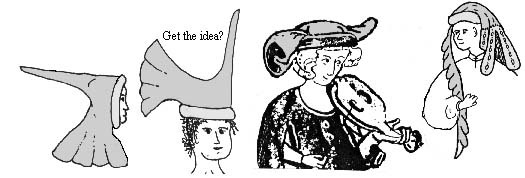
Sometime in the middle of this process, women started wearing stuffed-roll
hats. Sometimes these were just the roll, with decorations such as ribbons
or pearls, and other times they had liripipes and dagged `skirts' hanging
from them as if they were hoods that had been converted to hats. In the
later 1400s, they began to be worn under a shaped under-hat which raised
the outline into a heart shape,
or other shapes. Some of these underpinnings are clearly fabric over
some kind of under-structure, and some may be elaborately worked wire cages
with the hair showing through from inside. Also later in the century, they
put
the stuffed rolls on truncated-cone bases, so that the effect of the hat
was up, rather than out, as before. There were many very
odd combinations.
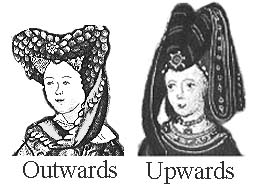
Veils were usually worn under the roll, or in later cases, propped up on pins to float over the top of the heart-shaped hat itself. I used to think that they were also worn over the roll, but I believe that arrangement to be inaccurate. Nonetheless, it looks "medievaloid" and is an easy way to wear the roll hat and provide some shade/breathability.
Most veils seem to be nearly transparent stiff fabric; often you can see lines where they have been folded, and the folds have remained. Some of these lines may also be seam lines, for very long veils. Sometimes there was no veil; in all the pictures I've seen, hats with veils had the hair hidden, and plain rolls (no veil) had the hair in a plait or hanging free down the back. You get either a veil, or hair, or dags; not more than one of these at a time. No hair shows in any of the taller Burgundian hats.
Most of my information is oriented towards Northern Europe, but women wore roll hats in Italy as well. The Italian versions were often much larger than the northern variants; up to a foot thick, to judge by the pictures. Very few Italian pictures use a veil, but they seem to be more likely to be heavily embroidered and embellished than the norther versions. Their northern cousins wore roll hats that were about the thickness of a forearm at most. The rolls should not get too thin -- they are not at all like the thin headbands currently fashionable! They should be at least 3" in diameter.
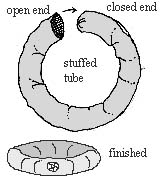 Suggested
fabrics: anything. Well, anything you'd wear to an SCA event. In general,
use woven natural fabrics, such as cotton, linen or wool. Veils should
be silk or very fine linen, but modern imitations will also look ok. If
you're not sure what sort of hat you want, or don't trust your design skills,
copy one of the ones in this handout, or from a medieval illustration.
Suggested
fabrics: anything. Well, anything you'd wear to an SCA event. In general,
use woven natural fabrics, such as cotton, linen or wool. Veils should
be silk or very fine linen, but modern imitations will also look ok. If
you're not sure what sort of hat you want, or don't trust your design skills,
copy one of the ones in this handout, or from a medieval illustration.
1. Cut a piece of fabric 1 yard long by whatever diameter roll you want. Cut this on the straight grain (square to the weaving), not on the bias. Most of my hats start 7" wide for a 6" final diameter. Sew it into a tube with one closed end; turn inside out. Some folks swear by cutting on the bias and stiff stuffing to eliminate interior wrikles. There aren't a lot of wrinkles with this on the grain method.
2. Stuff with stuffing. It's often very
useful to have some sort of "piston" to help you get the stuffing packed
in uniformly. Try a tall thin drinking glass or other cylindrical object.
The idea with the stuffing is to get it firmly enough to keep the shape,
but not so dense that it can't compress very well. You'll have to experiment.
A period source mentions the "hair of dead women," but since that's in
fairly short supply these days, I like to use the standard polyester stuffing
that you can buy in any fabric store. I have no evidence for the following,
but they might work well also: wood shavings (thin curls--not sawdust),
moss, spanish moss, fabric scraps, unspun wool. A friend recalls seeing
a round cork shape in a museum which was made to be rolled up inside a
hood to give the stuffed effect, but I do not have any source material
on this option.
Other options I have seen used an expandable aluminum dryer tube, fasioned
in a circle; it was lightweight and flexible -- both key points!
I've also seen one of those bound-straw wreath forms used; I wouldn't advise
these, as they are both heavy and not flexible. Although these hats
look round, they need to assume an oval shape when you are wearing them,
due to the way human heads are made. Another person speaks highly
of foam pipe insulation.
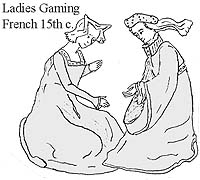 3.
As you stuff, occasionally bend the tube around your head to see how you
are progressing. When you get to the point where the closed end of the
tube and the empty end of the tube (where the stuffing ends) meet, it is
time to figure out exactly how tight you want the roll to fit. If you're
going to put a wire in the roll, to shape it into a V in front, now is
the time for that.
3.
As you stuff, occasionally bend the tube around your head to see how you
are progressing. When you get to the point where the closed end of the
tube and the empty end of the tube (where the stuffing ends) meet, it is
time to figure out exactly how tight you want the roll to fit. If you're
going to put a wire in the roll, to shape it into a V in front, now is
the time for that.
4. When you've got the perfect roll, tuck the non-filled part of the tube back inside its own end, leaving a 2" `collar' of open fabric at the end. Slide this over the closed end and baste together. Now you have a fine donut.
5. Trim with ribbon, or a round pin in center front. Veils can be held on with straight pins of almost any design.
6. As mentioned, some women, particularly in Southern Europe/Italy, didn't wear veils with these hats, so don't feel compelled to do so if it doesn't fit your garb. However, you can also sew on dags, liripipes or other fripperies if you want a more ornate hat. Veils should be white or off white, round, square, or oblong. Be guided by medieval illustrations.
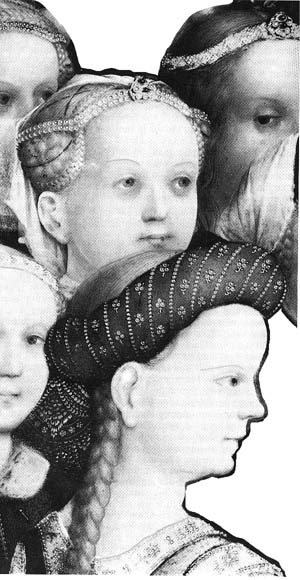 7.
How to wear your hair: As you can see from the pictures I've included,
usually something was going on with the hair, either a braid
down the back, or two braids looped or pinned on either side of the
face. Later on they started doing things with netting
and cauls. If you have short hair, you're home free--just don't let
your bangs show under the hat on your forehead. For longer hair: braid
your hair with beads or ribbon to match the outfit. You do this by dividing
your hair in two sections (not three) and using the beads as the third
strand. Once done, just finish it off with an elastic and tuck the end
up under the roll. This will muffle your hearing slightly, but it looks
great.
7.
How to wear your hair: As you can see from the pictures I've included,
usually something was going on with the hair, either a braid
down the back, or two braids looped or pinned on either side of the
face. Later on they started doing things with netting
and cauls. If you have short hair, you're home free--just don't let
your bangs show under the hat on your forehead. For longer hair: braid
your hair with beads or ribbon to match the outfit. You do this by dividing
your hair in two sections (not three) and using the beads as the third
strand. Once done, just finish it off with an elastic and tuck the end
up under the roll. This will muffle your hearing slightly, but it looks
great.
8. Lastly, there are some men's illustrations that could be variants on the roll hat rather than a modified hood. You can be the judge.
If you have questions, feel free to email me.
| All material (c) 1999 Cynthia Virtue | Email Author with comments |
| Back to Virtue Ventures Main Page | Back to Article Index |
